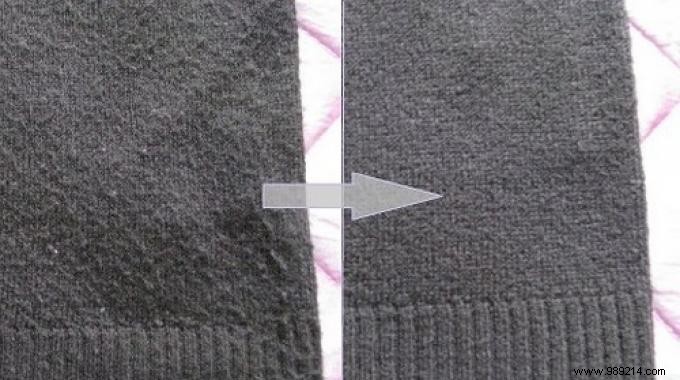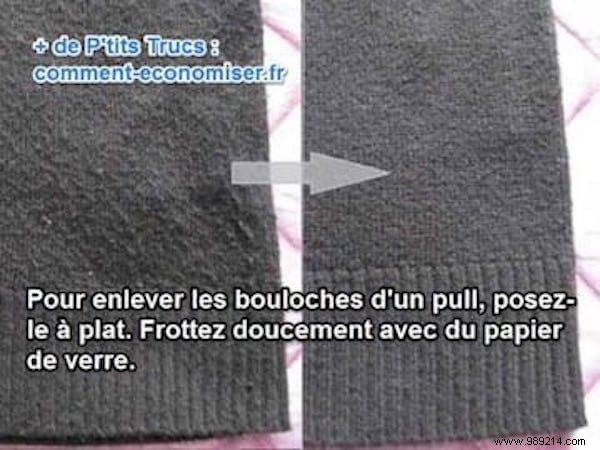
Over time, wool sweaters or scarves tend to full of little pills.
And it's really very ugly!
Can't stand wearing sweaters covered in unsightly little wool pills?
Do not panic ! There is no need to throw away your garment.
Fortunately, to remove them quickly and effectively, there are super effective tricks that really work.
Here are 14 incredible tips to remove pilling and give your sweater a second life. Watch:

The sandpaper not just for sanding...
It can be very useful for removing pilling .
It's surprising, but it works.
To do this, lay out your garment flat and take a piece of sandpaper.
Rub it gently against your garment. And all the little stuffed animals can be removed very easily.
Your sweater is like new and you can wear it again.
Obviously, we don't always have sandpaper on hand.
But it's very useful for a lot of things. You can get it here.
On the other hand, we all have a sponge at home.
But in general, we do not think of using it as an anti-pilling weapon.
Be careful, here you need a very clean sponge so as not to dirty your sweater.
Then it's child's play. Just pass the scraping side on the parts of the sweater that are damaged.
But I warn you, you have to go slowly so as not to damage the sweater.
The good news is that you will quickly see that the pilling stays on the sweater.
You probably know that sticky brush. All grandmothers have at least one.
It must be said that it is ideal for removing your dog's or cat's hair from your favorite clothes.
But did you know that this same brush can also remove pilling from your sweaters or coats?
It's fast and efficient!
Be careful, you just have to roll the brush on the fabric .
Do not rub it on it, at the risk of damaging your garment.
No sticky brush handy?
It does not matter, because you can replace it with a roll of adhesive tape.
Unroll part of it and put the sticky part on your sweater.
Repeat until there are no more pills.
You can also make your own sticky brush with tape.
Wrap a piece around your finger. Make sure the sticky side is on the outside.
And pat your sweater with it. All the pilling will stick to the tape.
The simplest solutions are sometimes also the most effective.
If you have time, you can remove the pills one by one , by hand.
A little long work of course, but you are guaranteed an impeccable finish.
And it is necessarily the most economical.
No need to go to Action or rush to Amazon to buy a device!
You must have everything you need... at hand.
That being said, it's easier if you have long fingernails.
It's time to steal your grandma's curlers! Not for styling...
But rather to remove the pilling on your garment!
Roll them over your garment to remove lint.
The curlers have a gripping surface and it's perfect to catch lint.
You can use this trick to remove pilling inside a sweatshirt.
It is an unusual use, but it is effective. So why not adopt it?
It's an unknown use of the freezer, I grant you.
The advantage of this option is that you don't waste time removing pilling.
Because you just have to put the sweater in a freezer bag, and hop in the freezer for a whole day.
Afterwards, you wash it in the washing machine using an appropriate program.
The cold has the advantage of tightening the textile fibres.
It therefore almost makes these little pilling on the surface of the textile disappear.
That's a great idea.
Especially if your sweater is itchy or if you have an angora sweater that is losing its hair...
Why ? Because the cold solves all these problems.
Yes, it's very surprising, but a pumice stone is not only used to soften the feet.
It is also a practical and effective tool against pilling.
It's the same principle as these pilling stones sold on the market.
The rubbing of the stone on the fabric helps to remove lint that protrude.
Layer it over your coat or sweater for easy removal.
Find out how to do it here.
If you have a cashmere sweater with pilling, this trick is for you.
Carefully run the teeth of the lice comb over the surface of the sweater to remove lint.
Your sweater will quickly regain a new youthfulness.
If you don't have a lice comb, use a simple comb with very fine, tight teeth.
For the maintenance of your cashmere piece, you can also invest in a comb for wool.
You have a piece of velcro tape left at the bottom of your sewing box?
Perfect, you can use it to remove pilling .
But take note of what I tell you. This method is not suitable for delicate fabrics.
You will quickly understand why.
It is in fact a question of laying the part with the hooks on the woolen garment.
Then we remove the band and all the pilling comes with it.
But if the sweater is fragile, you can imagine that it will also pull threads and damage the sweater.
But it works well on socks for example.
Do you have an old razor? So use it to remove fluff from your sweater or coat.
Simply pass it over the fabric laid flat to cut the protruding pilling.
Note that you have to be gentle and lightly pressed to avoid damaging your sweater.
If your razor is a little dull, even better. Because it is less sharp.
It's quite effective on a cardigan, a vest or even a woolen coat.
And it's a great way to recycle your old razor!
Do you like a job well done and meticulous?
So grab your tweezers and pull out those pesky pills one by one .
It's perfect for removing those that are small on flimsy sweaters or on cotton.
But of course, it might be a bit long...
There, we take out the big artillery. Perfect for when you're in a hurry!
If you have a wool sweater with big pilling, grab a pair of scissors .
And presto, cut them! It's fast and the result is perfect.
But of course, we don't do lace!
Do you know this device to get rid of pilling?
It is a special anti-pilling razor sold commercially.
It will give new life to your garment.
Once you put it on, it's as if your sweater was new!
You can also use it on your fabric sofa or on a mattress, without risk of damaging it.
Worth it, isn't it?
Find out how to use it here.
You may be wondering how to avoid pilling. It's quite simple.
Caring for your sweater is key to preventing the appearance of pilling.
- But first, know that it is better to choose sweaters with tight stitches . They are less prone to damage.
- Similarly, sweaters made of acrylic or other synthetic fibers pill more over time.
- Then when you wash your sweaters, put them inside out . At least the pilling appears on the unseen side.
- Choose a gentle washing program and prefer a liquid detergent.
- Be careful when wringing your sweaters. Go easy! Best to wring them yourself by hand gently twisting them.
- Then let them dry on a flat surface , covered with a towel, to avoid deformations.
- Avoid fabric softeners or choose a homemade fabric softener. Or opt for a special detergent for delicate fabrics.